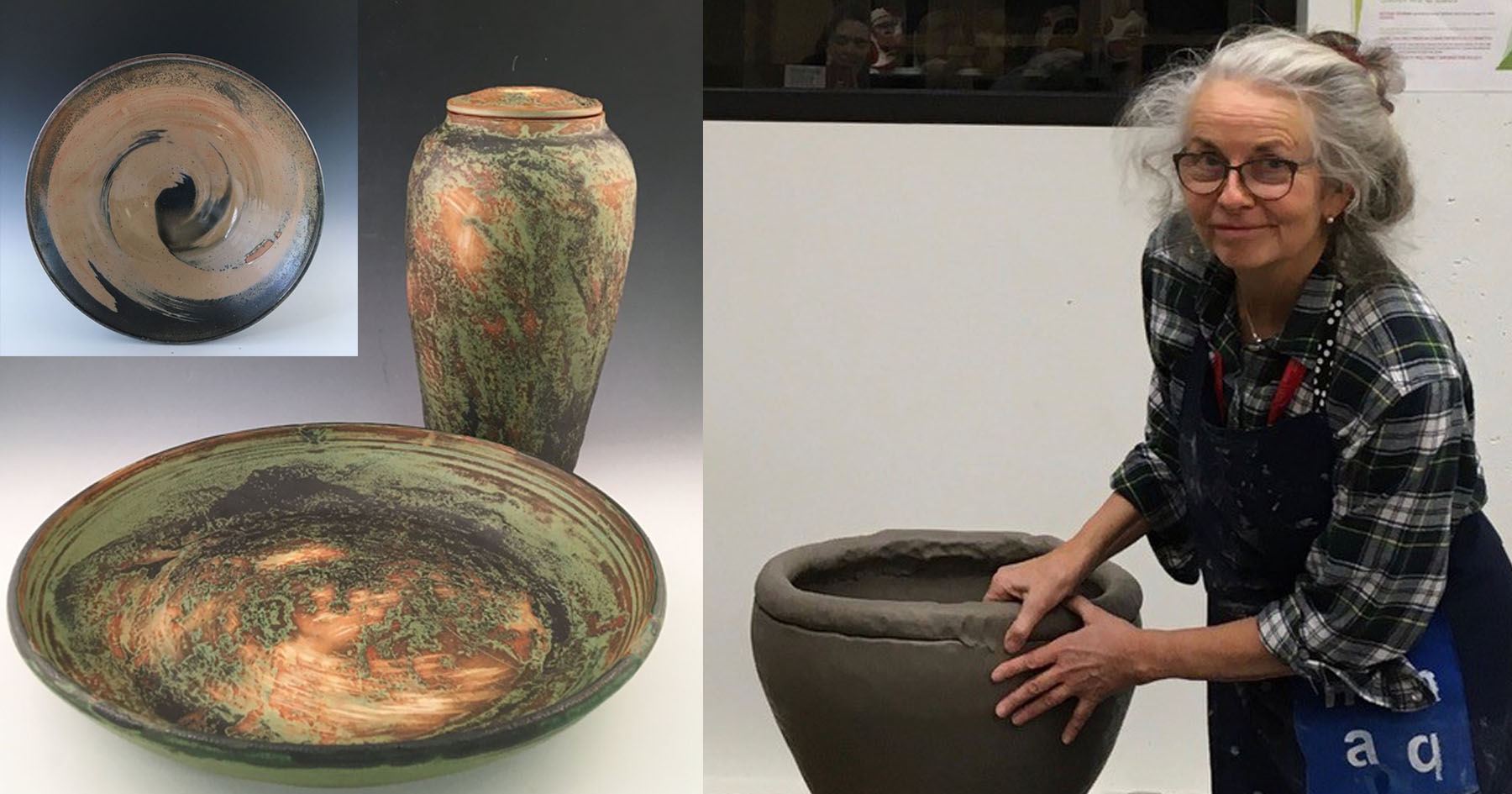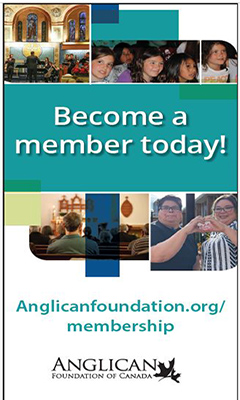Holly Ratcliffe wears many hats. Not only is she a theologian, an anthropologist and an associate priest at St George, Montreal, she is also a talented and recognized ceramicist. Holly is currently doing an artist-in-residency at the Centre for Studies in Religion and Society at the University of Victoria. Faith Tides had the pleasure to speak with Holly about her work and its themes, and about her ministry in the Anglican and Episcopal churches.
This interview has been edited for length and clarity.
Faith Tides: Holly, tell us about your work with clay. What drew you to it as an artistic medium? Did you start from a young age with mud pies in the sand box?
Holly: From childhood, I have drawn and painted and done papier mâché sculpture, that sort of thing. As for painting, I’ve done a fair enough of that over my lifetime to have an idea of what my style is, though I’m not active in it right now. I began to work with clay as a form of therapy. We worked in a group and there was someone to teach us and to give us some basic techniques. I’ve never looked back.
Clay is tactile, it is earthy and it allows us to bring our thoughts and feelings into expression. When we don’t have the words for what we want to say or need to say, clay serves as a preverbal medium.
Faith Tides: Much of your work in terms of forms, colours and textures makes one think of objects from antiquity, artifacts one might uncover in an archaeological dig or see in a museum. Are you inspired by the past?
Holly: That is the effect I am hoping to get. I have a background in anthropology as well as in theology. Actually, my first artist residency was at the Museum of Anthropology (MOA) at the University of British Columbia. There, I had daily exposure to its collection. I could see, for example, its ancient Asian — Chinese, Japanese and Korean — ceramics. So yes, that was really a kick start in that direction.
Faith Tides: You fully immersed yourself in ceramic arts in 2015. Why were you drawn to do this at this particular time and why focus on funerary urns?
Holly: I was nearing retirement, so it was timely. As for choosing to make urns, it’s partly because of my background as a priest. I’ve been with people in the last stages of their lives and with grieving people who have lost a family member or a loved one. I’ve officiated at many funerals. So that whole dimension of life is very familiar to me. I just sort of gravitated to making funeral urns. They have a function that is also highly symbolic.
Faith Tides: And there are historical examples. The ancient Egyptians used canopic jars to contain parts of the bodies of the deceased.
Holly: Absolutely. There is such diversity of practices around the world. That’s what I was discovering at MOA. You know, when a Korean princess was born, a beautiful celadon jar was made. After the birth, the baby’s placenta was placed into it! As Christians, in the creed we say we believe in the resurrection of the body. Historically, that has meant that our earthly bodies are to be treated with reverence. They are not just to be disposed of. But what happens so often at funerals is that the cremated remains are put into a very nondescript box.
Faith Tides: You’re interested in exploring the concept of “befriending our mortality” through clay. What inspired you to begin with?
Holly: In 2018, I made a life-size sculpture of a sarcophagus entitled À chaque semence son corps particulier (To every seed a body of its own). I was inspired by Paul’s reflection in 1 Corinthians 15 on the Corinthians’ question about what kind of body we will have in the Resurrection. It was a meditation on my own mortality so it had to be big enough for me. What inspired me to do this is a potter in England, Julian Stair, who spent 10 years preparing an exhibition of sarcophagi, ossuaries and funeral urns. I saw a photograph of his exhibition showing 10 or 12 standing sarcophagi in a room. It was very powerful in a contemplative way (see https://cfileonline.org/exhibition-julian-stair-quietus/).
Faith Tides: About our mortality, do you feel that we, in the West in particular, have a detachment from death? We’re very uncomfortable with it. For one thing, we mostly don’t deal with the actual process of death or what needs to be done afterwards. We leave it to professionals such as physicians and morticians.
Holly: It began to be very noticeable to me, even at the cégep (Cégep Limoilou in Quebec City) when I decided on my final project. Nobody wanted to talk to me about it. All these young kids were doing the usual cups, bowls and plates. They just kind of rolled their eyes at me.
Still, having exhibitions has been wonderful because that’s where I’ve been able to have conversations with people outside of the church context. When people come into a church, they automatically feel limited to a certain sphere of conversation. But at the exhibitions, there is nothing pressing them to speak in any particular way. That’s where, for me, the conversations are really interesting.
I began cultural mediation workshops for people who are interested in working with clay and discussing mortality. They want to talk about their own attitudes and contexts. People listen to one another speak and they share their fears and so on. And working with clay is a creative, playful way into the subject. While some cultures are more open to embracing death, here, we don’t talk about it.
Faith Tides: How did you get involved in the artist-in-residency program at the University of Victoria?
Holly: In 2020, I left MOA because COVID-19 was announced. As the pandemic went on, I started looking for artist residencies in Canada and I found one at the Centre for Studies in Religion and Society (CSRS). I made contact and discovered that one of the themes the Centre engages is that of religious understandings of a good death in palliative care. I was referred to the books that the Centre has published on that subject. I read them from cover to cover. It was the concept of pentimento that inspired me to create the project I’m working on here. Pentimento is the Italian word for repentance. It is used in oil painting to refer to the reappearance of an early sketch that was subsequently painted over and obliterated by the artist. More recently, biographical theorists use the word to refer to the reappearance of aspects of a person’s early life. In the books I read, the authors use this term to describe people who return to their early religious beliefs when they are dying.
My project is to research biographies of people, living or historical, in which individuals, who were raised in a religious tradition but abandoned it during their lives, have had that kind of spiritual homecoming at the end of their lives. And then, I create an urn which expresses something of each one’s pentimento, or spiritual homecoming, through layers of texture and glaze. I hope to have an exhibition of these urns. Each urn will be different of course and beside each one there will be a short biography.
Faith Tides: Prior to becoming a full–time ceramicist, you worked at different parishes including one in Oklahoma. What was that experience like?
Holly: I was in North Tulsa for my first parish. This is the Black side of town, where the race massacre of 1921 took place. St Aidan, Tulsa is the only Episcopal church there. I learned quickly that I knew nothing about race relations. That started my own education — which grew enormously while I was there — in recognizing my own systemic racist assumptions. I began to say to people I just met, “I don’t expect you to accept me,” and that often helped to break the ice.
Once I was asked to preach at a community service to which the whole of North Tulsa was invited. The gathering was to promote greater commitment to action in the community. What could I offer them? The sermon ended up being my confession to being a “recovering racist.” It was a powerful night. None of us are conscious of our own assumptions until we’re facing someone who hears what we are saying in a very different way. For example, coming from Southern Ontario in the late 1980s, I assumed that calling the police for help was a good thing. But this assumption was not necessarily shared by those with whom I worked. I had wonderful parishioners who were willing to hold my hand while they gave me this kind of feedback and helped me learn. I began to see the gospel in a new way, in their conviction that each was a beloved child of God — in the face of those who would not accept them.
Faith Tides: You then returned to Canada to serve in ministry, and you’re now at St George, Montreal as an honorary assistant. Tell us more about that.
Holly: I came to Quebec in 1991. I became rector of St Stephen, Lachine for seven and a half years. Subsequently, I was the director of Unitas, which at the time was a very active and high-profile ecumenical spirituality centre for Christian meditation. I then took a sabbatical to work on my doctorate on Julian of Norwich. Having completed that, I worked at Christ Church, Sorel-Tracy, the one fully Francophone mission in the Anglican diocese of Montreal. It was hard work, but it was really satisfying and creative. But after 11 years there of working entirely in French at Christ Church and then as a part-time prison chaplain for the Correctional Service of Canada, I became exhausted. That’s when I turned to ceramics.
You asked why I went to St George’s. At the time, I just I wanted to come home. I wanted to come to an English-speaking parish with a great choir and be able to preach, pray and sing in my own language. Over time, especially with COVID-19, we did a lot of work in raising our awareness of systemic racism. Because it is a very multicultural downtown parish — with people from the West Indies, Melanesia, Africa and so on — we had individuals interested in discussing such important issues in our online Zoom sessions. I think a lot of good work was done during COVID-19 in the parish.
Faith Tides: What’s your take on the future of Anglicanism in Canada? Certainly attendance, particularly in places like Quebec, isn’t what it used to be, and sadly many churches are closing.
Holly: Well, certainly Quebec is in a much worse situation in that sense of depletion. But anyway, being focused on death — and new life that can only come through death — is not such a bad thing when it comes to experiencing churches’ decline. Because then you begin to get into the habit of asking questions like, Where’s the meaning in this? How may our belief in the resurrection of Christ help us to understand death, as individuals and as communities?
There’s a woman here at CSRS who is from Czechoslovakia, and when she heard about my project, she put me in touch with a Czechoslovakian author. Under the communist regime, he became a Roman Catholic priest working underground. And so his whole experience has been of Christianity in a context in which the worldview is other than Christian. He talks about the “hidden Christ.” I think this is a theology for us — a theology for people for whom it isn’t just a nominal faith. It can call forth in us a self-understanding and an understanding of community that is very different from what we have known or have assumed in Christendom.
Faith Tides: You’ve been quoted recently saying that the “strands of my life are coming together.” How so?
Holly: I never thought that I’d be an anthropologist again or exploring other cultures the way I did when I was in my 20s. And I see my work as a ceramicist as being in continuity with my life as a priest too.
Faith Tides: You mentioned your 20s. What advice would you have now for your 20–year–old self?
Holly: (laughs) Oh, I don’t have any advice for my 20-year-old self. I need the advice now!
For more information about Holly’s work as a ceramic artist, visit: https://www.hollyratcliffeceramic.ca.
On April 6, Holly will be presenting a public lecture Pentimenti: Ceramic Funeral Vessels as Biographies of Spiritual Homecomings as part of the Centre for Studies in Religion and Society’s weekly lecture series. All are welcome to attend in person or online via a Zoom link. For more information, please go to https://www.uvic.ca/research/centres/csrs/events/.

















